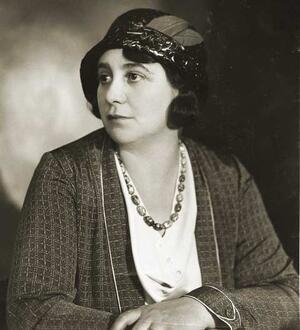Katie Gluckmann
Born in Ukraine to Lithuanian parents in 1884, Katie Gluckmann moved to South Africa with her mother. As a young woman, she became deeply involved with Zionism and rose quickly to positions of leadership in the movement through her work ethic and charisma. She was an elected member of the executive board of the Zionist Conference every year from 1928 to 1949, and when male Zionists fought the creation of a South African branch of the Women’s International Zionist Organization in the 1930s, Gluckmann helped create the South African Zionist Council, refusing to surrender their right to participate in the Zionist movement. Gluckmann made Aliyah in 1949, becoming part of the WIZO executive board and chair of the Mothercraft Training Center in Tel Aviv.
Early Life and Leadership
Katie Gluckmann was born in 1884 in Odessa, while her mother Gennie Baxt was on vacation there from her home in Shavli, Lithuania. Her father died soon afterwards and her mother immigrated with her to South Africa, where her mother’s sister had settled in Paarl, Western Province. Gennie moved to a Jewish suburb of Cape Town where she supported herself and her teenage daughter from her earnings as a seamstress. Later she married a man named Cohen and they moved to Vrededorp, the Jewish slum in Johannesburg.
Katie had already become an enthusiastic Zionist in Cape Town and, despite her youth and being a female in a male-dominated movement, she rapidly became a prominent propagandist for the movement. In 1903 she married a lawyer, Emanuel Gluckmann (1881–1953) and they had four children. She rose with surprising speed to positions of leadership in the Zionist Movement in South Africa. Marcia Gitlin, in her definitive history of South African Zionism up to 1950, The Vision Amazing (Johannesburg 1950) wrote: “There were women whose work and ability earned them recognition not only from their immediate colleagues but also from the broad ranks of South African Zionists in general, and at the eleventh Zionist Conference in 1928 Mrs. Katie Gluckmann was elected by a unanimous vote a member of the Executive of the Federation—not because she represented any special section of the community…but in her own right…. ‘Our Katie,’ as she was called by all South African Zionists, came to be a familiar, much loved figure wherever she went. Her emotional warmth, her transparent sincerity, her flashing eyes and her sparkling wit, her fads and foibles—they were all aspects of a personality that was both unique and original and which was for long a part of the fabric of South African Zionism.” She was re-elected a member of the Executive of the Federation in all the years that followed, until she immigrated with Emanuel to Israel in 1949. Simultaneously she was also chairwoman of the Keren Kayemet in South Africa throughout this period.
Involvement with WIZO and Later Activism
Dr. Chaim Weizmann and his wife Vera Weizmann visited South Africa in 1932 to launch a Keren Hayesod campaign, after he had been demoted from his post as the head of the Zionist Movement. Vera, who had helped to promote the establishment of WIZO, the Women’s International Zionist Organization, was determined to establish a branch in South Africa. She enrolled Katie Gluckmann, Ethel Hayman, Dr. Hedwig Reinhold, and Anna Braudo to help her do so. When the men who ran South African Zionism proved vigorously opposed to having a WIZO branch in South Africa, the women formed the South African Zionist Council, with Dr. Hedwig Reinhold as chairwoman.
After Katie immigrated to Israel, she became a member of the Israel Committee of the Federation; she also served on the WIZO Executive and became Chairwoman of the Mothercraft Training Center, established in Tel Aviv by the South African Women’s Zionist Council as their WIZO project.
Family Legacy of Zionism and Later Life
Emanuel passed his law examinations and was admitted to the Israel Bar. He also became an insurance agent. After his death in 1952, Katie carried on his insurance agency with great success.
Gluckmann’s success in inculcating her Zionist fervor in her family is illustrated by the careers of her children. Her oldest son, Colin (1909–1961), immigrated to Israel in 1936 and married Saada Frumkin, the daughter of Judge Gad Frumkin and Anna Frumkin. He became Israel’s second State Attorney in 1952. At Ben-Gurion’s insistence, he changed his surname from Gluckmann to Gillon.
Gluckmann’s second son, Max (1911–1975), who became Professor of Social Anthropology at Manchester University, was also instrumental in setting up a department of social anthropology at Tel Aviv University. Her third son, Philip (1913–2003), a journalist, went to Israel in 1951 and became a founder and town clerk of Ashkelon. Her daughter, Joyce Miller (b. 1919), went to Palestine in 1947. She later became a senior lecturer in the English Department of the Hebrew University and was prominent in the promotion of English theater in Israel.
During Gluckmann’s lifetime, the Keren Kayemet planted a forest in her honor at Neve Ilan, a Cooperative smallholder's village in Erez Israel combining some of the features of both cooperative and private farming.moshav in the Judaean mountains. She died in Jerusalem in 1968.




